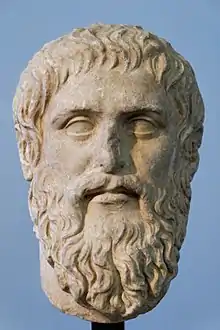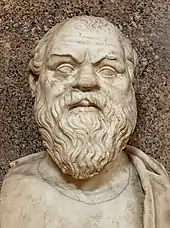The following is a list of the speakers found in the dialogues traditionally ascribed to Plato, including extensively quoted, indirect and conjured speakers. Dialogues, as well as Platonic Epistles and Epigrams, in which these individuals appear dramatically but do not speak are listed separately.
List
- Unnamed speakers
| Name | Mentioned |
|---|---|
| Callias' slave | Protagoras |
| Euclides' slave | Theaetetus |
| Meno's slave of Pharsalus | Meno |
| Polemarchus' slave | Republic |
| Public slave | Phaedo |
| Stranger from Athens | Epinomis, Laws |
| Stranger from Elea | Sophist, Statesman |
| Unnamed friends | Eryxias, Hipparchus, Minos, On Justice,[1] On Virtue,[4] Protagoras, Rival Lovers, Symposium |
Notes
- 1 2 A small minority of manuscript traditions name Clinias as the anonymous speaker in On Justice: D. S. Hutchinson in Cooper, p. 1689.
- 1 2 Scholars are divided as to whether the Critias depicted in the Timaeus and Critias dialogues is the future member of the Thirty Tyrants who appears elsewhere in Plato's writing (Critias IV), or rather his grandfather (Critias III): Nails, 106–7.
- ↑ Not all scholars are convinced that the Glaucon mentioned in Symposium is Plato's brother.
- 1 2 A small minority of manuscript traditions name either Meno or the otherwise unknown Hippotrophus as the anonymous speaker in On Virtue: D. S. Hutchinson in Cooper, p. 1694.
- ↑ Sisyphus of Pharsalus lived in the time of Plato, and thus is to be distinguished from the Sisyphus of Corinth in mythology: Cooper, p. 1707.
- ↑ The identity of the Socrates named in Epistle XI is unknown, but is considered by some scholars to be that of the young Socrates of the Statesman trilogy: Cooper, p. 1672.
- ↑ Scholars are unsure as to whether Epigram 8 is intended to reference Socrates' wife Xanthippe or another individual by the same name: Cooper, p. 1742.
Bibliography
- Debra Nails. The People of Plato: A Prosopography of Plato and Other Socratics. Hackett Publishing, 2002. ISBN 0-87220-564-9.
- Plato. Complete Works. Ed: John M. Cooper. Hackett Publishing, 1997.
This article is issued from Wikipedia. The text is licensed under Creative Commons - Attribution - Sharealike. Additional terms may apply for the media files.

